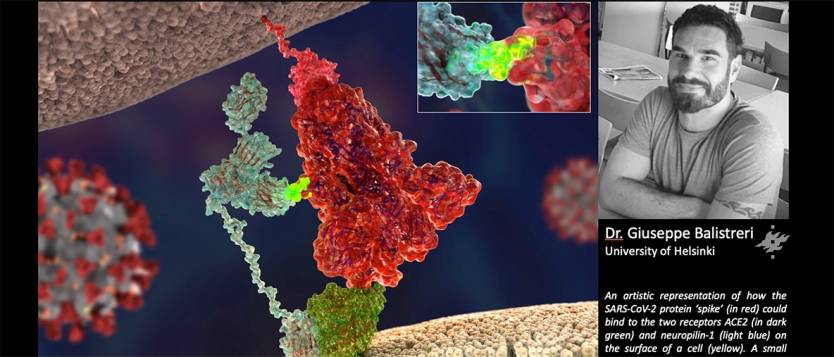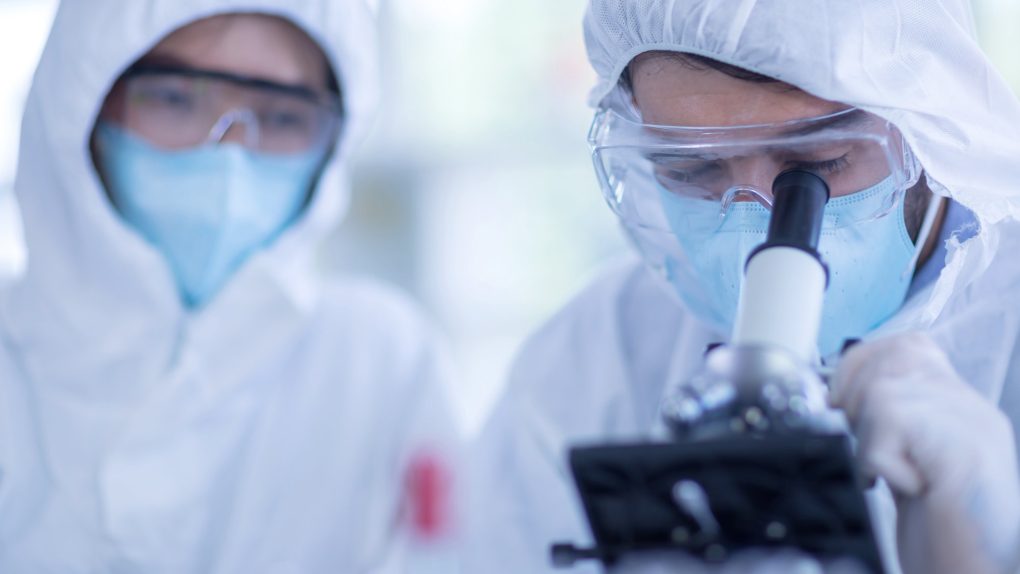- Researchers may have discovered a previously unknown step involved in the mechanism that allows the novel coronavirus to infect cells.
- Scientists have discovered that SARS-CoV-2 binds to a receptor called neuropilin-1, which is found in various places inside the human body. That connection facilitates the critical link-up between the spike protein and the ACE2 receptor.
- By blocking neuropilin-1 in cell cultures, scientists were able to significantly reduce the coronavirus’s ability to infect a person.
Scientists figured out months ago how the novel coronavirus binds to cells. Then they discovered a mutation that allows SARS-CoV-2 to attach to ACE2 receptors even more efficiently than before. That mutation doesn’t make the virus more lethal than before, just more contagious. Separately, researchers have been looking at ways to block the spike protein from linking up to cells. Blocking this process would prevent the virus from entering cells and replicating, and would ultimately lead to clearing the virus faster from the body. The neutralizing antibodies that coronavirus survivors develop, and which vaccines would teach the immune system to create, could block the spike protein and prevent it from hooking up to the ACE2 receptors. That’s the idea, at least, as vaccines are still in development so it’s unclear whether they can block infections.
Now, new research may have uncovered a key detail about the process that allows the virus to hook up to cells. The discovery might help drugmakers create other therapies that could further target the spike protein and prevent it from linking to ACE2 receptors.
Scientists from Finland and Germany have concluded that a receptor called neuropilin-1 is involved in the process whereby the virus infects cells. “That SARS-CoV-2 uses the receptor ACE2 to infect our cells was known, but viruses often use multiple factors to maximize their infectious potential,” Dr. Giuseppe Balistreri said in a statement. “Unlike the main receptor ACE2, which is present in low levels, neuropilin-1 is very abundant in the cells of the nasal cavity. This is a strategically important localization possibly contributing to the efficient infectivity of this new coronavirus, which has caused a major pandemic, spreading rapidly around the world.”
The scientists compared SARS-CoV-2 with its precursor, SARS-CoV, which was responsible for the SARS outbreak in 2003. That virus wasn’t as efficient at spreading as the novel coronavirus, so the researchers set out to determine why.
“When the sequence of the SARS-CoV-2 genome became available, at the end of January, something surprised us,” Balistreri said. “Compared to its older relative, the new coronavirus had acquired an ‘extra piece’ on its surface proteins, which is also found in the spikes of many devastating human viruses, including Ebola, HIV, and highly pathogenic strains of avian influenza, among others. We thought this could lead us to the answer. But how?”
Balistreri partnered up with other experts and looked into the importance of neuropilin receptors in the novel coronavirus spread.

The researchers studied the receptor in cell cultures in a lab, using specific antibodies to block it. They discovered that neuropilin-1 is a key instrument the virus uses to reach ACE2 receptors.
“If you think of ACE2 as a door lock to enter the cell, then neuropilin-1 could be a factor that directs the virus to the door. ACE2 is expressed at very low levels in most cells. Thus, it is not easy for the virus to find doors to enter. Other factors such as neuropilin-1 might help the virus finding its door,” Balistreri said.
The researchers also discovered that neuropilin-1 might explain why many patients lose their sense of smell and taste. The receptor is found in the nasal cavity cell layer, and the researchers examined tissue samples from deceased COVID-19 patients. “We wanted to find out whether cells equipped with neuropilin-1 are really infected by SARS-CoV-2, and found that this was the case,” Technical University of Munich professor Mika Simons said.
Simon, a co-leader of the study, also explains that the neuropilin-1 receptor can move some viruses to the brain, at least in experiments with mice. However, that’s not an indication that the novel coronavirus can be carried from the nose to the brain. “We could determine that neuropilin-1, at least under the conditions of our experiments, promotes transport into the brain, but we cannot make any conclusion whether this is also true for SARS-CoV-2. It is very likely that this pathway is suppressed by the immune system in most patients”, Simons said.
The researchers are now studying ways of blocking neuropilin-1 in COVID-19 therapy but warn that more research is required. “It is currently too early to speculate whether blocking directly neuropilin could be a viable therapeutic approach, as this could lead to side effects,” Balistreri said. “This will have to be looked at in future studies. Currently, our laboratory is testing the effect of new molecules that we have specifically designed to interrupt the connection between the virus and neuropilin. Preliminary results are very promising, and we hope to obtain validations in vivo in the near future.”
The full study is available in full in Science magazine.
What’s interesting about the neuropilin-1 receptor is that it came up recently in a different type of COVID-19 research. Scientists from the University of Arizona Health Sciences also found that SARS-CoV-2 binds to neuropilin-1, but they associated the phenomenon with an unexpected side-effect. By blocking the receptor, the novel coronavirus gets in the way of transmitting pain, effectively blocking a person from feeling some pain after infection. This could explain why many people do not experience any pain-related symptoms.
As with other COVID-19 studies, more research is required to determine the role of neuropilin-1 in a coronavirus infection. If these findings can be confirmed, scientists may be able to develop new drugs that can prevent the virus from linking up to neuropilin and to ACE2 receptors.








